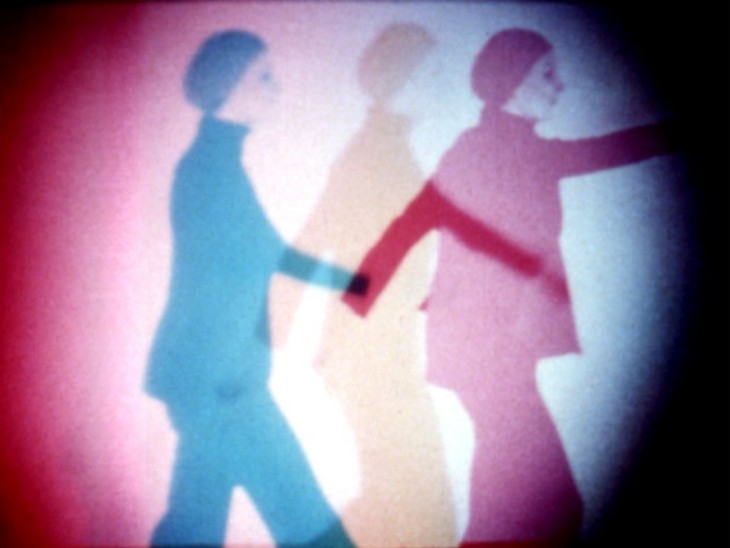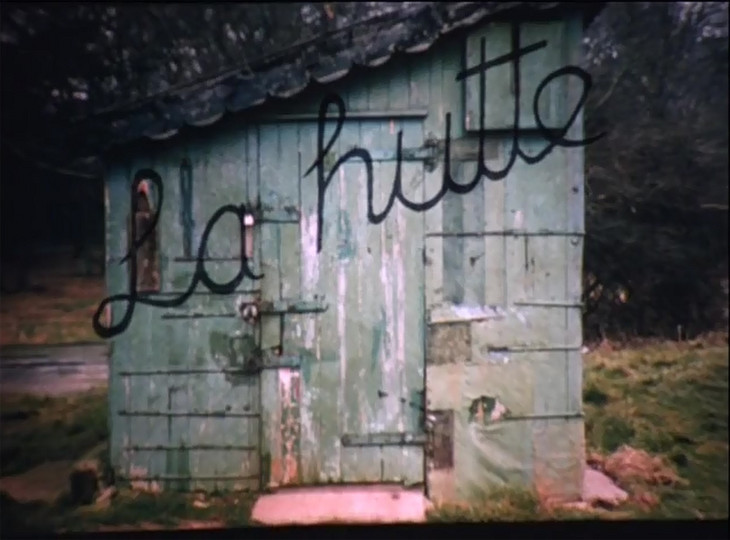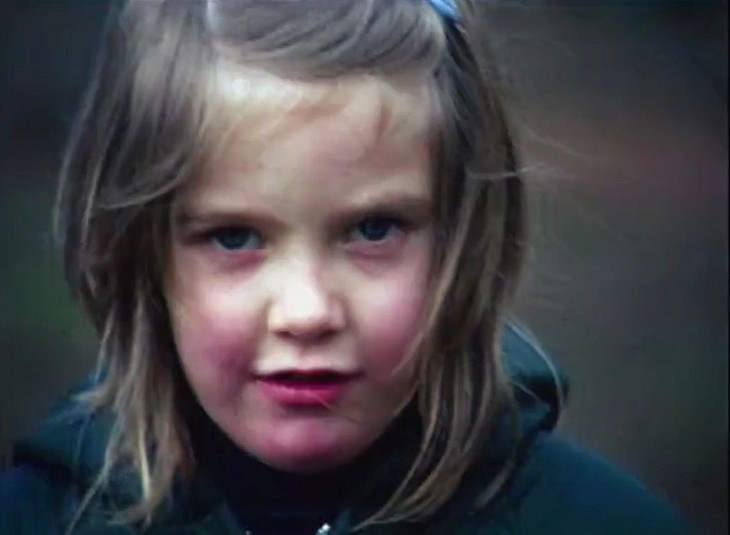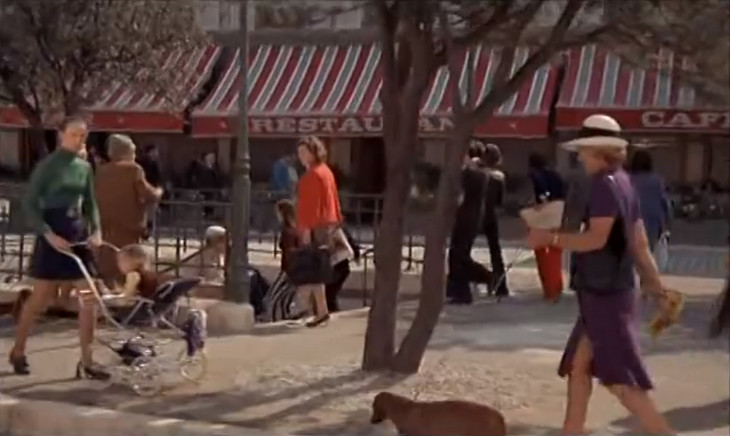Context and Conception

John Smith
Someone Moving 1972 (film still)
5 min
Courtesy the artist
Fig.1
John Smith
Someone Moving 1972 (film still)
Courtesy the artist
Smith had come to North East London Polytechnic after spending a year on a graphic design course at Hornsey College of Art. He had wanted to study fine art but had chosen design in an effort to appease his parents. At North East London Polytechnic he began a course in communication design, which included substantial instruction in what might today be called media studies. It was there that he encountered Guy Sherwin, an experimental filmmaker teaching at the college who was starting to get involved with the London Film-makers’ Co-operative (‘the Co-op’) at the time. It was Sherwin who would be responsible for introducing Smith to the history of avant-garde cinema and for arranging Smith’s first public screening, as part of a mixed programme of films by students from the college, held on 25 January 1974 at the Co-op, then located in a former dairy at 13a Prince of Wales Crescent in Kentish Town. In Time Out, filmmaker and critic John Du Cane previewed the event, describing it as follows:
Some interesting work by Liz [sic] Rhodes and John Smith with printing, loops and frame by frame letrasetting, a good film by Ian Kerr using rephotography and some good camera-work by Tim Bruce and Andrew Charles, plus a film-performance called the Golden Age of the Silver Screen. Much more watchable film than you’d normally expect from this sort of area.2

John Smith
The Hut 1973 (film still)
Film, 16 mm, colour, sound
5 min
Courtesy the artist
Fig.2
John Smith
The Hut 1973 (film still)
Courtesy the artist

John Smith
The Hut 1973 (film still)
5 min
Courtesy the artist
Fig.3
John Smith
The Hut 1973 (film still)
Courtesy the artist

John Smith
The Hut 1973 (film still)
Courtesy the artist
Fig.4
John Smith
The Hut 1973 (film still)
Courtesy the artist

John Smith
The Hut 1973 (film still)
Courtesy the artist
Fig.5
John Smith
The Hut 1973 (film still)
Courtesy the artist
Smith often locates the beginning of what one might call his mature period of filmmaking with the production of Associations 1975, the first film he made as an MA student at the Royal College of Art’s Film and Television School.3 However, while still at North East London Polytechnic, Smith made The Hut 1973, a lesser-known yet accomplished film that serves as a bridge between the early abstract works and the interlocking concerns with narrative, humour and cinematic reflexivity that would be central to The Girl Chewing Gum. The Hut begins with a title card reading ‘La hutte’, rendered in a cursive font that invokes the French avant-garde of the 1910s and 1920s (fig.2).4 This title is superimposed over an image of an office for boat rental on a lake in Epping Forest, one that looks as if its best days are long in the past. The film begins with a downward tilt over out-of-focus tree branches, accompanied by a female voiceover saying: ‘I was walking through the forest one day, when suddenly I saw it’. The camera comes to rest on the face of a woman in medium close-up, sporting an expression somewhere between startled, frightened and amazed (fig.3). The voice continues, ‘The hut’. Two seconds of flickering alternations between still images of the sea-foam green hut are followed by a cut back to a close-up of the woman’s wide eyes. The film then enters into a montage of various details of the weathered and rusted hut, its paint chipping away (fig.4). As momentum builds, many shots appear to be no more than a single frame. The film comes to a climax with an extremely fast, almost vibrating flicker that finally rests on a frontal shot of the hut. After barely a second, a medium close-up of a young girl appears and the same voiceover returns, exclaiming: ‘I was amazed!’ (fig.5). The girl promptly exits the shot, the camera swiftly zooms out to reveal a clearing in the forest, and the film ends – so abruptly and without explanation that it ventures into the domain of absurdist humour.
The Hut may be considered a documentary of place insofar as it engages in a fastidious examination of the architectural details of a small, worn shack. Yet the film makes no attempt to present the hut ‘as it is’. Rather, at its core The Hut is a film concerned with the transformative possibilities of cinematic vision. The figure of the woman-turned-girl is a spectator who witnesses a sight wondrous enough to return her to her childhood, a fantastical metamorphosis that might be seen to allegorise the recalibration of seeing that is the mandate of much avant-garde film. Experimental filmmakers of many different stripes have emphasised this potentiality of the medium, formulating its precise character in varying ways.5 The framing narrative of The Hut casts its long middle section as just such an engagement with visionary experience and metamorphosis. It proposes that by changing the way we see the world – by taking the banal and making it miraculous – the cinema can render back to it something of the enchantment it held when we were children.
The structural/materialist cinema that dominated British avant-garde film practice at the time was deeply committed to a critique of cinematic illusionism.6 It was marked by a desire, to borrow the words of film theorist Christian Metz, to ‘break open the toy and see into the guts of the machine’, thereby disrupting its ideological function.7 Despite possessing a formal rigour often associated with this tendency, The Hut, with its playfully surrealist sensibility, diverges from structural/materialist film by situating itself firmly on the side of cinematic fascination and the expanded perceptual possibilities the medium offers. It is in this respect closely tied to Smith’s earliest quasi-psychedelic works, such as Triangles and Someone Moving, which participate in the forms of mind-expansion and hallucinatory vision that were at play in countercultural movements of the time. However, as an allegory of cinematic representation and experience, The Hut also prefigured to some degree the concerns with mediation and reflexivity that would mark The Girl Chewing Gum. Even at this early stage in his practice, Smith proved very suspicious of naturalism and of the impression of reality so dear to dominant cinema. Documentary was present as a concern, but any hint of transparency was vanquished as transfiguration took precedence over testimony. The hut that the woman-turned-girl sees is precisely not the mundane hut that existed in Epping Forest; the hut she sees exists in the cinema alone and is endowed with marvel only through Smith’s deployment of filmic language. This notion – that cinematic conventions serve to transform the viewer’s apprehension of profilmic reality – is, of course, the central preoccupation of The Girl Chewing Gum. Although articulated very differently in the two films, both recruit fiction and first-person voiceover as means of interrogating the way in which the spectator’s experience is shaped through the manipulation of the image.
It is worth underlining the extent to which the particular character Smith has ascribed to that spectatorial experience changes strikingly between The Hut and The Girl Chewing Gum. In The Hut, one finds an interest in the oneiric, uncanny and wondrous, all of which one might align with a particular form of cinephilia. Three years later with The Girl Chewing Gum, this was quite distinctively displaced by a critical project invested in dismantling the cinema’s impression of reality, now understood as eminently ideological. This political imperative extended across film theory and practice during the period, often adopting its methodology from the forms of semiotic analysis that took hold in the 1960s and which were very much in the air when Smith began postgraduate study at the Royal College of Art (RCA) in 1974. Although self-avowedly not a ‘theory person’, Smith had studied the economy of signification in advertising while on his aborted graphic design course.8 During his MA, this interest in semiotics was nurtured by RCA tutors including Peter Gidal, a leading proponent of structural/materialist film, and Jorge Dana, a filmmaker and theorist.
While Smith’s relation to Gidal and structural/materialist film is perhaps of greater significance,9 it is worth noting here the impact of the lesser-known figure of Dana, particularly because his attitude towards narrative was much more moderate than Gidal’s and thus closer to the strategies Smith would deploy in The Girl Chewing Gum. Dana’s interest in the semiotics of the cinema is perhaps best exemplified by a text he co-authored with Noël Burch, who had also been a tutor at the RCA but left before Smith’s arrival. Entitled ‘Propositions’, this essay was published in Afterimage in spring 1974 as part of a special issue entitled ‘Aesthetics/Ideology/Cinema’. Modelled after Jean-Louis Comolli and Jean Narboni’s 1969 Cahiers du cinéma editorial ‘Cinema/Ideology/Criticism’, ‘Propositions’ advanced a taxonomic system for classifying films based on the relationship between ideology and form found within them. The text showed a clear investment in politicised modernist production, but concentrated primarily on an analysis of the codes that functioned within canonical works of narrative film history, including The Cabinet of Dr Caligari (Das Cabinet des Dr Caligari) (dir. Robert Weine, 1920), Citizen Kane (dir. Orson Welles, 1941) and Gertrud (dir. Carl Theodor Dreyer, 1964). Burch and Dana posited that dominant cinema inherits codes from the literature of the eighteenth and nineteenth centuries that work to secure the ‘guarantee of linearity and illusionist effect’.10 Making use of a vocabulary heavily informed by French structuralism, and more particularly the importation of Saussurean semiotics into areas beyond the properly linguistic, they advocated modernist filmic practices that disrupted this linearity and illusionism in favour of work on the signifier that would make visible processes of enunciation and effect a defamiliarisation of filmic language. Such films are designated as belonging to ‘category D’ and are described as follows: ‘Films which are informed by a constant designation/deconstruction of the codes which, however ideologically determined at the strictly diegetic level, implicitly question this determination by the way they situate the codes and play upon them’.11 The authors offer Gertrud as an example, but one might also see The Girl Chewing Gum as falling under this heading due to its appropriation and subversion of commonly employed cinematic codes.
Conventional narrative film constituted a bad object for much avant-garde film production in the early 1970s, as it was seen as a tool of manipulation and mystification used to inculcate viewers with dominant ideology. It was, however, from this domain that Smith first got the idea for The Girl Chewing Gum, in particular from François Truffaut’s 1973 film Day for Night (La Nuit américaine). Truffaut’s paean to the labour of filmmaking is rather conservative; indeed, the film is a textbook example of exactly how thoroughly the potentially disruptive force of reflexivity can be recuperated. Yet Smith gleaned from it a crucial insight. Day for Night begins with a travelling shot just over a minute long that pans and tracks its way through a bustling city square in France (fig.6). Children play, cars go by and people enter and exit the subway. Two men meet, framed in medium long shot; one delivers a faux slap to the other, breaking the impression of reality that has prevailed this far. There is a cut back to the director, played by Truffaut himself, yelling ‘Cut!’ In a split second, the scene the viewer had apprehended as the ‘real’ world of the film is recast as the filming of a street scene on a movie set. A few minutes later, after the assistant director has delivered extensive notes on all that went wrong, another take is filmed. This time, the scene is replayed with Truffaut supplying directions in voiceover: ‘The lady with the dog, walk faster please. More action in the subway. Send in the white car’, and so on. The sequence was a revelation for Smith:
Believe it or not, I was really surprised to discover that the people in the background were being directed in their actions. Even the dog was instructed to piss up a lamp-post. Until then, I had assumed that extras in street scenes were real passers-by going about their business. I was already a filmmaker and I thought to myself how naïve I had been about the ‘realism’ of fiction films. The Girl Chewing Gum came out of the shock I felt at the power of the illusion of cinema.12
The title of Truffaut’s film itself gestures to the artificiality of filmic realism; ‘day for night’ refers to the technique of shooting night sequences during the day using specialised film stock or blue filters, a practice that came to be known in France as ‘the American night’ due to its frequent employment in the westerns of the classical era. Truffaut thematised this embrace of artifice at the diegetic level in relation to the shooting of the film-within-the-film, but nowhere does Day for Night confront or compromise the illusionary coherence of its own diegesis.13 This would fall to The Girl Chewing Gum, in which Smith would wrest Truffaut’s lesson of filmic constructedness out of art cinema and into the avant-garde.
The production process of The Girl Chewing Gum was relatively simple. Smith shot the film with an Arriflex 16 mm camera and Nagra tape recorder borrowed from the RCA. Although he owned a Bolex at the time, this camera would not allow him to shoot synchronised sound in the street, something that was key to the conceit of the film. Smith shot no footage beyond that included in the film, with the result that its production costs were very low. Its materials amounted to one 400-foot roll of black and white 16 mm film for the street scene, one 100-foot roll of black and white 16 mm film for the 360-degree pan, the developing costs for each, tape to record the sound, and the cost of producing a final print that included the magnetic soundtrack. Smith has estimated a total expenditure of a ‘couple of hundred pounds’, which was covered by a £500 gift in support of his work he had received that year from Ken Campbell, one of his ex-tutors from North East London Polytechnic.14
Smith enlisted Patrick Duval, a friend and fellow student, to help with the sound recording since it would have been physically impossible for one person to carry both the camera and the sound equipment. The pair set off for their chosen location in Dalston, which was around the corner from Smith’s flat in Lansdowne Drive. In addition to it being close to where he lived, there were three factors that led to the selection of the precise location that appears in the film: Smith wanted it to be ‘an ordinary environment’; he was interested in the presence of the Dalston Odeon since he was making a ‘film about cinema’; and lastly he was keen to include the clock as a way of making clear that he was not directing everything – its hands could be relied upon to move regularly without any prompting from Smith.15 For the 360-degree pan, he sought an outdoor location easily accessible from the RCA with no traffic noise, so that sound recorded there could be convincingly mixed with the location sound from Dalston. Not particularly familiar with West London, he asked a fellow student to recommend a place and was directed to Letchmore Heath – half an hour’s ride away on his motorbike.
After the footage had been processed, Smith sat at a Steenbeck editing table with a stopwatch to write the script, balancing what he wanted to say against what he would be able to fit in. The original script is just over two pages long, typewritten, and largely conforms to the voiceover heard in the film.16 Smith’s initial idea was to write a voiceover directing the image-track. In some cases, he already had a clear idea of how this would work while filming; in others, he responded to the contingencies of what he had captured. For instance, the burglar alarm heard prominently on the soundtrack had not been planned, but simply had been ringing on the afternoon Smith and Duval had turned up to make the film. For some time, they waited for it to end, but eventually decided to film while it was going on since time was running out and Smith was afraid he would have to wait weeks to borrow the equipment again. The alarm in turn became a central part of the film’s narrative, motivating a crime story of a man who has robbed a post office – something that never would have otherwise been part of the film. The treatment of the clock presents a curious mixture of the planned and unplanned, figuring as what Smith names as one of his favourite moments of the film. As noted above, the opportunity to direct the clock had been part of what had first attracted Smith to the site. But when he got back the developed film he was disappointed with its first appearance due to the jerkiness of the camera, which zooms out for just a moment before zooming in. This was remedied by an improvisation in the writing of the script, which states ‘I want the clock to move jerkily towards me’, thus recasting what might have been a slight technical error as a perfect execution of the command.
After the script was written, Smith recorded the voiceover and edited the soundtrack to fit the picture. A print was made, and The Girl Chewing Gum was ready to be seen.
Notes
John Du Cane, untitled film listing, Time Out, 25–31 January 1974, p.31. The film by Rhodes and Smith that Du Cane refers to here is Words 1973.
Associations is the earliest film listed in the ‘selected works’ available on Smith’s website (http://johnsmithfilms.com/selected-works , accessed 11 June 2015) and is the first discussed in the written component of Smith’s PhD thesis, ‘Real Fiction’, submitted in 1997 at the University of East London.
Smith recalls seeing many films from this period while studying with Sherwin at North East London Polytechnic.
A key text in this regard is Stan Brakhage’s Metaphors on Vision (1963), in which the filmmaker describes how the cinema might provide a way of reimagining the prelinguistic vision of the child. This line of thought is also common outside the avant-garde, particularly in classical film theory. Among the most influential formulations are Walter Benjamin’s notion of the ‘optical unconscious’ and André Bazin’s statement in ‘The Ontology of the Photographic Image’ that ‘Only the impassive lens, stripping its object of all those ways of seeing it, those piled-up preconceptions, that spiritual dust and grime with which my eyes have covered it, is able to present it in all its virginal purity to my attention and consequently to my love.’ See André Bazin, What is Cinema? Volume 1, Berkeley 1967, p.15; Walter Benjamin, ‘The Work of Art in the Age of Its Technological Reproducibility (Second Version)’, trans. by Edmund Jephcott and Harry Zohn, in Howard Eiland and Michael W. Jennings (eds.), Walter Benjamin: Selected Writings, Volume 3, 1935–1938, Cambridge, Massachusetts 2002, p.117; Stan Brakhage, ‘From Metaphors on Vision’, in P. Adams Sitney (ed.), The Avant-Garde Film: A Reader of Theory and Criticism, New York 1978, pp.120–8.
For a discussion of structural/materialist film and the Co-op at this time, see Erika Balsom, ‘A “New Face” at the Co-op’, September 2015, in Erika Balsom (ed.), In Focus: ‘The Girl Chewing Gum’ 1976, by John Smith, September 2015.
Christian Metz, The Imaginary Signifier: Psychoanalysis and the Cinema, trans. by Celia Britton, Annwyl Williams, Ben Brewster and Alfred Guzzetti, Bloomington 1982, p.93.
For an extensive discussion of the film’s relationship to structural/materialism, see Erika Balsom, ‘A “New Face” at the Co-op’, September 2015, in Balsom (ed.) 2015.
John Smith, quoted in Catherine Elwes, ‘Trespassing Beyond the Frame’, in Mark Cosgrove and Josephine Lanyon (eds.), John Smith: Film and Video Works, 1972–2002, Bristol 2002, pp.65–6. Although there are two dachshunds and a miniature poodle in the opening sequence, none is in fact directed to urinate; there is, however, a scene later in the film in which the crew runs into difficulty as they attempt to direct a kitten to drink from a saucer of milk.
This failure was at the heart of Jean-Luc Godard’s criticism of the film, elaborated in a letter that would precipitate the end of his longstanding friendship with Truffaut. See Antoine de Baecque and Serge Toubiana, Truffaut: A Biography, trans. by Catherine Temerson, Berkeley 2000, p.300.
For a full transcription of the original script, see John Smith, ‘Original script for the voiceover to The Girl Chewing Gum’, 1976, in Erika Balsom (ed.), In Focus: ‘The Girl Chewing Gum’ 1976, by John Smith, September 2015. There are a few remarks present in the script that are omitted in the film, most notably the final scripted command, ‘Now disappear’. The sole significant alteration is in the location of the field, specified in the script as an ‘enormous golf course’ in Epping Forest.
How to cite
Erika Balsom, ‘Context and Conception’, September 2015, in Erika Balsom (ed.), In Focus: 'The Girl Chewing Gum' 1976 by John Smith, Tate Research Publication, 2015, https://www

